Essay: When Home-Visiting Nurses Face Violence

[This essay was first published in STAT News, a subsidiary of the Boston Globe, Jan. 12, 2021].
It's a difficult time to be a nurse. It's an even more difficult time to be a home visiting nurse.
This large group of health care providers, who are largely invisible in the media, are poorly paid and more stressed than ever before.
As a former visiting nurse at one of New York City's largest home health care agencies, I know firsthand what these caregivers face when they cross the threshold of a patient's home. In the best situations, it's a patient's gratitude for coming to provide comfort, reduce isolation, and maybe even spark a little conversation. At other times, coming through that door provokes intense discomfort. Dread. Even danger and violence.
As Covid-19 surges and Americans' need for in-home care grows — given the fear of contagion in hospitals and clinics, America's rapidly aging population, and many people's understandable wish to age in place — ensuring the safety of this group of caregivers is more important than ever. Home visiting nurses already put themselves at considerable risk by entering patients' homes, even though they don personal protective equipment, are vigilant about hand and shoe hygiene, and keep their distance when possible.
250,000+
According to the Bureau of Labor Statistics, there are more than 250,000 American home-health care nurses
Covid-19 has caused a surge in attrition among home visiting nurses, many of them veteran nurses who were initially attracted by the flexibility of the work. That has strained home health care agencies and the patients and families who rely on them. As we near the one-year mark of this pandemic in the U.S., a dwindling number of professionals are willing to do this kind of work.
That has as much to do with violence as it does with the virus.
Even before the pandemic struck, I heard nurses' stories of home visits — some were during my time as a visiting nurse, and others were as part of my study to understand violence faced by home visiting nurses. They told me about patients who blared pornography, or being groped while administering care. About patients who waved handguns and hurled racial insults. About being bitten, punched, kicked, or slapped. About dealing with screaming fits, intoxicated family members, and dogs that bit them or threatened to.

Some of this happens to nurses working in hospitals. But hospitals have policies they impose on patients during their stay that affirm, "You can do this, but you can't do that." They also have security staff who can help. Visiting nurses, however, go into patients' homes alone, where they're guests — and the rules at play can be vastly different from home to home.
Many home visiting nurses I've interviewed view endure this violence as a necessary evil, as "just part of the work." They are often uncertain about what constitutes physical, emotional, or psychological abuse — what actually crosses the line. And though home health agencies are required to have violence-reporting protocols in place, nurses don't often document violence when it happens or seek help from their managers. For some, violence has become so abundant and routine that reporting it feels like an administrative burden. Others don't want to relive the trauma.
One study found that 88% of violence experienced by hospital workers were not documented in the formal reporting system. Among home visiting nurses, the rate of patient-on-nurse violence is largely unknown. Based on a meta-analysis I conducted with several colleagues, roughly half of home visiting professionals, most of whom are nurses, experience verbal abuse each year, and 15% experience physical abuse. The actual number, though, is likely higher.
When these nurses do document violence, I've found that they tend to do it in less formal ways, using clinical notes as the repository rather than the formal channels that home health care agencies establish. These clinical notes provide a rich electronic repository of the violence visiting nurses face, acting as conversations between nurses who use them to communicate risks and warn one another about what they may face when caring for a patient. While these notes work for that purpose, they don't help home health care agencies address the problem and protect their nurses.
If we understand how home visiting nurses report the violence they experience, we can better advocate for their safety. We begin that process by understanding the scope of the problem. Only then can managers and others can take steps to ensure home visiting nurses' safety and embrace reporting systems that are safe, easy, and effective to use. Simply put, we must know where and how to look for the violence in order to stop it.
On any given day, more than 250,000 home visiting nurses are at work caring for Americans and their loved ones. They offer vastly underappreciated care that homebound people desperately need. At a moment when so much is riding on this critical avenue of care and companionship, it is important to draw attention to working conditions that cause visiting nurses distress and burnout because, at a certain point, it becomes too much to bear. If violence isn't understood, addressed, and mitigated, we cannot protect this vital resource that so many of us rely on.
It takes courage to cross a stranger's threshold and offer care and comfort and support. It's become common to herald bedside nurses and other frontline Covid-19 caregivers as heroes. Let us also appreciate the essential services that home visiting nurses provide by doing for them what they do for us: provide safety and succor.
Ha Do Byon is an assistant professor of nursing at the University of Virginia School of Nursing. His pilot study that examines nurses’ clinical notes to identify violence is funded by a grant from the Eugenie and Joseph Doyle Research Partnership Fund.
###
